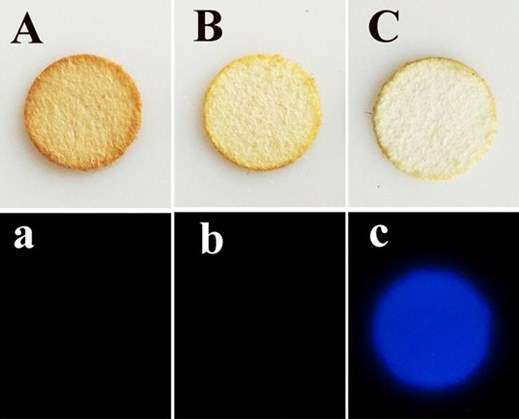Detecting bloodstains—with an antimalarial compound

As seen on crime shows, investigators use a combination of luminol and other substances to light up bloodstains at crime scenes. But now, researchers report in ACS' journal Analytical Chemistry that combining luminol with artemisinin, a natural peroxide and antimalarial treatment, reduces the risk of false positives compared to the traditional method.
Luminol is often combined with hydrogen peroxide to react with the heme groups in blood, producing a bright blue glow, known as chemiluminescence. This glow allows crime scene technicians to detect blood that has dried on surfaces or to detect blood that someone tried to clean from a surface. While this test has proven beneficial in numerous criminal investigations, it isn't perfect. False positives due to interferences from biomolecules and metal ions, as well as from the breakdown products of hydrogen peroxide, can occur. In an effort to minimize erroneous identifications, Guobao Xu and colleagues investigated the use of a compound called artemisinin, commonly known as a treatment for malaria, with luminol. Artemisinin is more structurally sound and is more resistant to interferences than hydrogen peroxide.
The researchers showed that the luminol-artemisinin combination is more selective than luminol-hydrogen peroxide, resulting in fewer false positives when challenged with components of bleaches and disinfectants, which criminals often use to cover up a misdeed. The researchers found that the method could distinguish blood from coffee, tea and brown sugar stains. They also obtained test results with the new luminol method using a smartphone, which could provide highly accurate on-scene analyses.
More information: Wenyue Gao et al. Artemisinin-Luminol Chemiluminescence for Forensic Bloodstain Detection Using a Smart Phone as a Detector, Analytical Chemistry (2017). DOI: 10.1021/acs.analchem.7b01000
Abstract
Forensic luminol chemiluminescence test is one of the most sensitive and popular methods for the determination of latent bloodstains. It mainly uses hydrogen peroxide or sodium perborate as coreactants. The easy decomposition of hydrogen peroxide and sodium perborate in the presence of many ions significantly affects the selectivity. Artemisinin is a natural peroxide that is quite stable in the presence of common ions. In the present study, artemisinin has been exploited for the forensic bloodstain chemiluminescence detection for the first time. Using smart phone as cost-effective portable detector, the visual detection of bloodstains has been achieved with a dilution factor of blood up to 100 000. Moreover, this system shows excellent selectivity against many common species. It can well differentiate bloodstains from other stains, such as coffee, brown sugar, and black tea. Both favorable sensitivity and selectivity makes the present method promising in forensic detection.
Journal information: Analytical Chemistry
Provided by American Chemical Society
















